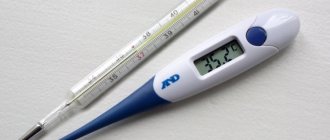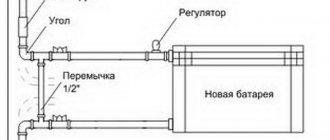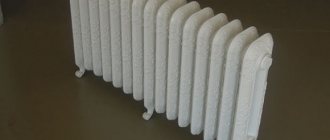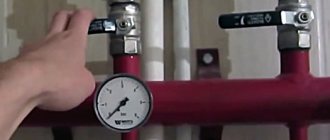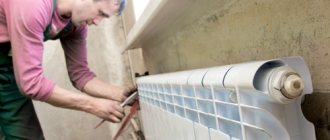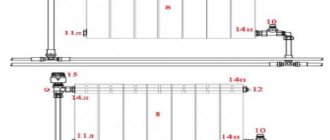The heating battery is leaking - what to do?
The first thing to do if the radiator is leaking, as in the photo, is to turn off the water. But if the leak is serious, then it is urgent to call an emergency team - plumbers have all the necessary tools and materials to eliminate the problem if the battery leaks.
If boiling water is pouring out of the radiator in all directions, then you need to throw something thick over it - for example, a blanket. This is not a way to get rid of a leak, but at least you will be able to approach it without fear of injury.
Next, if possible, you need to turn off the water. It’s good if there is a tap or valve in the apartment itself - this will allow you to quickly turn off the water supply and save your property. But what if there is no such valve and the radiator is leaking - what to do? Then you need to turn on the coolant supply valve to the heating system, which is located on the main pipe near its entrance to the basement. If the leak is minor, then you can try to fix it yourself (for more details: “How to fix a leaking heating pipe if it is leaking”).
Types of leaks
Each connection of parts represents a potential threat of possible depressurization.
Please note: a leak is the release of coolant from the heating system due to damage in one of the elements.
Depending on the type of connecting elements used, there are several types of leaks that are typical for heating batteries:
- leakage resulting from a crack in the battery section;
- damage to the tightness of the main pipes that connect the main riser to the batteries;
- leaks in the intersection connections of the heating radiator;
- depressurization of the connection between the radiator and pipes.
Each type of leak needs to be repaired using certain repair methods.
How to fix a leak
There are several options for solving the problem, using:
- self-tapping bolt;
- rubber pad with wire or clamp;
- cement-plaster bandage;
- fabric impregnated with heat- and water-resistant glue;
- special sealant;
- welding
The easiest way to fix a small leak in a cast iron radiator is to fix a self-tapping bolt in the hole.
It must be remembered that all these methods of eliminating leaks are only a temporary measure - it is advisable to replace old radiators with new products as soon as possible.
Cement-plaster dressing to eliminate leakage of the heating radiator
Before fixing a leak in the heating battery, you need to prepare the required materials and tools:
- cement;
- alabaster (plaster);
- container with water;
- salt;
- medical bandage
To eliminate the leak, a bandage is applied to the damaged area.
The procedure after turning off the water is as follows:
- dilute cement in a container with water to the consistency of thick sour cream;
- cut the bandage into strips 25-30 centimeters long;
- thoroughly soak the bandage with the cement mixture;
- wrap strips around the damaged area.
The process is repeated until a durable bandage is obtained.
If it was not possible to turn off the water, then instead of cement you need to use alabaster, which dries much faster. Then a cement bandage is applied to the plaster cast.
If the heating battery leaks at the threaded connection, you can use salt:
- wet strips of cloth or bandage in water;
- roll the material thoroughly in salt;
- wrap the leak area.
The gap will close as a result of the salt dissolving in the water. A cement bandage is applied on top.
Using a clamp and rubber as a means to eliminate radiator leaks
If the damage is located at the junction of the main pipe and the radiator, then the leak can be removed for a while using wire and a rubber band (car clamp). A piece of rubber is wrapped around the damaged area and secured with wire.
If you cannot find a special remedy for eliminating radiator leaks, then you can simply cut pieces of rubber from a bicycle inner tube - the strips should be 30-35 centimeters long and 4-5 centimeters wide. Using a clamp, you can stop the leak for a while. For this reason, it doesn’t hurt to have a few clamps in stock at home - their price is low.
Elimination of fistula
For any breakdown there are a number of reasons accompanying it. A fistula on heating system pipes or on a radiator is no exception. If a small brown spot appears on the elements of the heating network, you should not think that it is paint coming off. In fact, this is the beginning of an often irreversible process, but knowing how to repair a fistula in a cast iron battery, you can stop the destruction and extend its service life. Causes of corrosion:
- Taking into account the frequent increases in the cost of utilities, some craftsmen are cunning and, in order to save energy, connect a neutral cable to the heating circuit. The currents that begin their “journey” through the pipes through the coolant are what cause the formation of corrosion. You can identify a dishonest neighbor if there are several fistulas and they appear with a certain regularity. Calling the appropriate service to identify the intruder and repairing cast iron batteries yourself will help save the situation.
- Too much acidity of water can harm even corrosion-tolerant cast iron.
- The batteries have expired or deposits on the battery walls have damaged the metal. In this case, even a small fistula or crack under the influence of water pressure can cause the battery to burst and a stream of hot water to flow from it.
Any of the options requires urgent intervention. If the cast iron battery leaks only slightly, then you can do without disconnecting the circuit and dismantling it. A clamp can save the situation. If the water only drips, then a one-sided clamp will do, but if it runs in a thin string, then it is better not to risk it and use a double-sided clamp.
In the event that the coolant ruptures the place where the fistula was located, the question immediately arises whether it is possible to weld a cast-iron battery. As a rule, cold welding becomes an emergency solution, but even if it has restored the tightness, it is necessary to call specialists from the heating network to check the condition of the heating system.
Hermetic seal to eliminate leaks
As for how to fix a heating radiator leak, if there is minor damage, you can use a powder or polymer-based sealant. They can be found in hardware stores.
Such a composition polymerizes upon contact with air, and as a result of hardening, a strong filling is formed, which gives time for significant repairs. Some sealants are two-component polymer compounds, and harden as a result of mixing their two components. Other products harden as a result of a chemical reaction with air. Using sealants designed specifically to fix leaks, you can solve the problem in a matter of minutes.
Actions in case of leakage
When urgent measures do not give a positive result, you need to drain the water from the system and make high-quality repairs to the damaged area.
For this:
- turn off the tap on the riser, warning your neighbors if it is a common valve;
- drain the water from the system.
Knot near the riser
One of the common damages is at the junction of the riser and the pipe. Leakage in this area may occur due to poor sealing of the joint. It is possible that when attaching the pipe, they did not put enough windings on the thread or did not tighten the lock nut.
The connection must be disassembled and re-twisted. Use tape or sealing thread to wind the FUM. It is advisable to replace the locknut. If the weld seam is leaking, then the water from the riser must be drained and the seam made again. To do this, you need to hire a welder.
Radiator sections
Radiator sections are pulled together. There are rubber gaskets at their junction points. Over time, the tie may loosen or the gaskets may become unusable. Water makes its way at the junctions of the sections. First, use adjustable wrenches to tighten the connection without removing the radiator.
If this does not help, then remove the faulty battery. Shut off the water supply, drain the water from the system and unscrew the radiator. Disassemble into elements, install new gaskets. Clean the sections from slag. Reassemble and install.
Battery input
Warm water flowed where the pipe enters the battery. This is a threaded connection consisting of a drive, a coupling and a lock nut. These elements are made separately and sometimes not from high-quality metal. In addition, if the battery is cast iron and poorly secured to the brackets, it creates pressure that deforms the joint over time.
This unit definitely needs to be replaced. It happens that it is impossible to unscrew rusted parts, then they are heated with a gas burner
This operation is carried out with extreme caution, having prepared fire extinguishing agents and fencing the work area with protective screens made of non-combustible materials.
Battery edge
If a crack forms in an accessible area of the battery fin, it can be temporarily neutralized. There are 2 types of welding of heating batteries: hot and cold.
If the battery registers are metal, then hot welding can help fix the leak. If they are aluminum or cast iron, then you can forget about it. In this case, cold welding will help. This requires a high-temperature, water-resistant plastic mass that reacts chemically with such metals.
The area to be welded must be thoroughly cleaned, degreased and dried. Knead the substance until it is homogeneous, apply a small layer and let it harden. Welding products such as ABRO STEEL or POXIPOL do an excellent job. The range of such adhesives is wide. You can select welding for the material from which the radiator is made.
Faucet or joint
When the source of the leak is a faucet, it must be replaced. If the tap has not been used for a long time, it becomes clogged with deposits and does not fulfill its task. However, if its rotating part is moved out of place, it can also leak. When choosing a new shut-off device, give preference to ball valves made of non-ferrous metal.
Leaks at joints can be eliminated by wrapping the damaged area with a bandage soaked in saline solution. After drying, cover the top with a bandage soaked in a mixture of plaster and cement.
Modern industry offers consumers plate glue for this purpose. You should wrap the finished strip around the leak area. When exposed to air, the polymer hardens and eliminates the problem. When using silicone sealants to eliminate leaks at faucet joints or threaded connections, choose neutral compounds. Acid-based sealant may promote subsequent metal corrosion.
Welding Application
If you have certain skills and a welding machine, you can simply weld the leak. This is the best way to solve the problem, but it is not suitable for all radiators - only for steel appliances.
If the battery is leaking, what should you do? The first thing you need to do is stop the water supply to the heating device. It’s good if the leak occurred in the summer, but much more often they happen during the heating season. Since you can simply scald yourself with hot water, you must first turn off the coolant supply.
In case of serious damage, it is necessary to call an emergency team - experienced plumbers will be able to quickly solve the problem.
If the leak is small, then it can be eliminated using improvised means. But you need to remember that any method of eliminating a leak will only help temporarily restore the operation of the heating device, so it is recommended to change it in the near future. One way to fix a battery leak is shown in the video:
